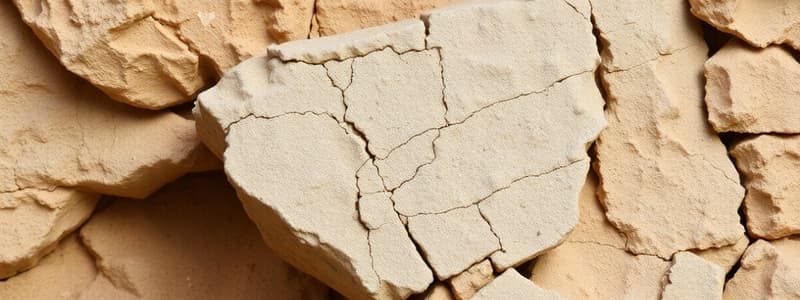Podcast
Questions and Answers
What type of weathering involves the alteration of minerals through chemical reactions?
What type of weathering involves the alteration of minerals through chemical reactions?
- Physical Weathering
- Chemical Weathering (correct)
- Mechanical Weathering
- Biological Weathering
Which of the following is NOT an agent of erosion?
Which of the following is NOT an agent of erosion?
- Sunlight (correct)
- Wind
- Water
- Ice
What process is responsible for the formation of distinct layers in sedimentary rock?
What process is responsible for the formation of distinct layers in sedimentary rock?
- Erosion
- Sediment Deposition (correct)
- Compaction
- Sediment Transportation
Which type of load refers to particles that are carried along the bottom of a water body?
Which type of load refers to particles that are carried along the bottom of a water body?
In sediment deposition, what factors primarily influence the sorting of particles?
In sediment deposition, what factors primarily influence the sorting of particles?
Which type of weathering is influenced by living organisms, such as plant roots and lichens?
Which type of weathering is influenced by living organisms, such as plant roots and lichens?
What occurs during compaction in the context of rock formation?
What occurs during compaction in the context of rock formation?
Which of the following environments is NOT associated with sediment deposition?
Which of the following environments is NOT associated with sediment deposition?
What is the primary process involved in cementation of sedimentary rocks?
What is the primary process involved in cementation of sedimentary rocks?
Which of the following is NOT a common cementing agent in sedimentary rocks?
Which of the following is NOT a common cementing agent in sedimentary rocks?
Which type of sedimentary rock is characterized by formation from fragments of other rocks?
Which type of sedimentary rock is characterized by formation from fragments of other rocks?
What do the Principles of Original Horizontality and Superposition help to understand?
What do the Principles of Original Horizontality and Superposition help to understand?
Which type of sedimentary rock is primarily formed from mineral precipitation in evaporative settings?
Which type of sedimentary rock is primarily formed from mineral precipitation in evaporative settings?
What is a significant factor in the fossilization process of organisms?
What is a significant factor in the fossilization process of organisms?
Which of the following scenarios primarily leads to erosion and exposure of sedimentary rock layers?
Which of the following scenarios primarily leads to erosion and exposure of sedimentary rock layers?
Which natural resource is NOT typically associated with sedimentary rocks?
Which natural resource is NOT typically associated with sedimentary rocks?
Flashcards are hidden until you start studying
Study Notes
Cementation
- A process where minerals precipitate and bind sediment particles together.
- Common cementing agents include quartz, calcite, and iron oxides.
- Authigenic cementation occurs in place, while diagenetic cementation happens during later stages.
Types of Sedimentary Rocks
-
Clastic Sedimentary Rocks
- Formed from fragments of other rocks.
- Major types are sandstone, shale, and conglomerate.
- Grain size and sorting influence rock classification.
-
Chemical Sedimentary Rocks
- Result from mineral precipitation in environments like evaporative settings or hot springs.
- Types include limestone, halite, and gypsum.
-
Organic Sedimentary Rocks
- Derived from organic materials, with types such as coal and oil shale.
- Typically formed in peat bogs or marine settings rich in organic productivity.
Stratigraphy and Geological History
-
Principles of Stratigraphy
- Superposition governs the order of sedimentary layers.
- Original horizontality refers to sediment layers forming horizontally.
- Lateral continuity discusses the extent of strata.
- Cross-cutting relationships help in interpreting geological structures.
-
Fossilization
- Requires specific conditions for preservation.
- Body fossils represent remains, while trace fossils show activity.
- Biostratigraphy utilizes fossils for dating rocks.
-
Uplift and Erosion
- Tectonic uplift creates mountain ranges and affects sediment layers.
- Erosion occurs through various processes exposing sedimentary rock layers, crucial for geological mapping.
-
Geologic Mapping
- Involves techniques for mapping sedimentary layers and interpreting map data.
Environmental and Economic Significance
- Natural resources include coal, oil, natural gas, and groundwater.
- Sedimentary rocks provide indicators for interpreting past climates and environments.
Real-World Examples
- Notable sedimentary rock formations include the Grand Canyon and Niagara Falls.
- Historical and contemporary research focuses on sedimentary rock studies.
Formation of Stratified Rocks
- Characterized by visible layering and planes of stratification.
- Form via weathering, sedimentation, compaction, and cementation.
- Layers assist in determining Earth's geological history.
Processes of Sediment Formation and Transportation
-
Weathering
- Physical weathering types include freeze-thaw, thermal expansion, and abrasion, leading to rock fragmentation.
- Chemical weathering involves oxidation, hydrolysis, and dissolution, affecting mineral composition.
- Biological weathering is influenced by organisms like plant roots and lichen.
-
Erosion
- Agents include water (rivers, ocean currents), wind (deflation, abrasion), and ice (glaciers).
- Erosion shapes landforms like valleys, canyons, and deltas.
-
Sediment Transportation
- Types of sediments include gravel, sand, silt, and clay.
- Transport mechanisms vary by bed load (rolling, sliding), suspended load (particles in water), and dissolved load (minerals in solution).
-
Sediment Deposition
- Environments include terrestrial (riverbeds, lakes, deserts), marine (coastal areas, deep sea), and transitional (estuaries, tidal flats).
- Sorting occurs by particle size and density, while layering reflects distinct layers formed under varying conditions.
Compaction in Stratified Rock Formation
- Compaction decreases pore space and increases sediment density.
- Affects sediment texture and alters porosity and permeability.
Studying That Suits You
Use AI to generate personalized quizzes and flashcards to suit your learning preferences.




